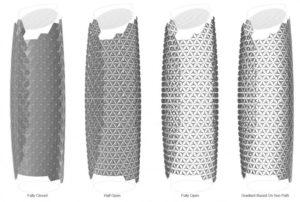

The heat and glare of the Abu Dhabi sun poses a huge challenge in shading the interior spaces while allowing for adequate daylighting. For the Al Bahar Towers, the team of architects from Aedas took inspiration from the Mashrabiyah, a jaali like lattice screen used in traditional Arabian architecture as a shading device. A secondary façade of interlocking triangular modules was created which open and close responding dynamically to how much sunlight is incident. This second skin hangs like a curtain wall two metres away from the primary glass façade.
Using parametric models for the shading panels, the computational design team at Aedas was able to simulate their operation for different solar conditions throughout the year – varying solar angles and sun exposure. Each unit comprises of stretched PTFE (polytertaflouroethylene) panels and coated with micro fibreglass. The interlocking geometric facade comprises of over 1,000 moving elements, controlled by a building management system to create a smart responsive façade. The south facing roof of the towers incorporate photo voltaic cells that generate about 5% of the building’s energy needs, and also drive the system of computer controlled façade panels.
All the screens fold at night to reveal more of the internal façade. As the sun rises from the east in the morning, the screens along the east of the building begin to close. Through the day as the sun moves around the building, the strip of closed panels moves across the façade, performing their job of controlling solar gain. The whole system is protected by a variety of sensors that open the units in case cloud and wind conditions change.
It is estimated that this screening system cuts out approximately 50% of solar heat gain, effectively reducing the air conditioning load inside the building. Additionally as the panels even in their closed condition filter some light into the building, they reduce the offices’ dependence on artificial light. The result is a much more energy efficient architectural solution to office space requirements that is contextually and climatically relevant to the Middle East. The twin towers save a lot of energy that would have been required for cooling and lighting loads which can be calculated as a reduction of CO2emissions of 1,750 tonnes per year.
Such an intricate system of responsive façades has been employed for the first time at such a large scale. It has cleverly taken cues from Pritzker prize winner Jean Novel’s responsive façade at Monde du Arabe(1981) and evolved it to the next level. The towers have been one of the first in the Gulf to receive a LEED silver rating. For the project’s sustainable engineering and sensitive cultural and urban approach, the towers were also awarded the 2012 Tall Building Innovation Award by the Council of Tall Buildings and Urban Habitat.
Project facts
Project: Abu Dhabi Investment Council Headquarters
Location: Abu Dhabi, UAE
Architects: Aedas Architects Ltd
Structural/ MEP Engineering: Arup
Completion Date: June 2012
Height: 145m (29 Stories)
Area: 56,000 Sq.m

